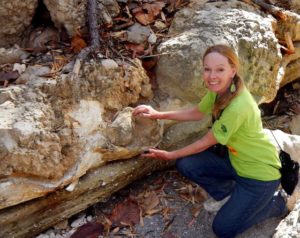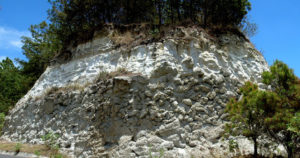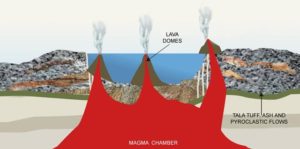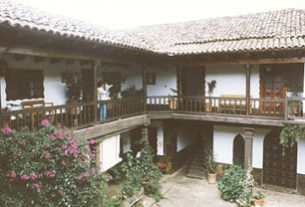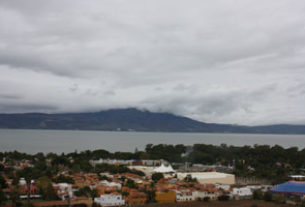On Wednesday, March 6, 2013, the first book ever on the geology of the Primavera Forest was launched at ITESO University in Guadalajara. La Apasionante Geología del Área de Protección de Flora y Fauna La Primavera was written by U.S. Peace Corps Volunteer and geologist Barbara Dye during her two years of service at the woodland sanctuary. Although written in Spanish, the 72-page book has so many stunning color photos and drawings that it could also be considered a coffee-table book which speakers of any language will enjoy perusing.
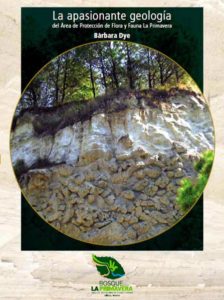
For most people who live in Jalisco, Barbara Dye’s book will be a real eye-opener. What we call a forest, she tells us, is also home to a volcano just as real as Colima’s Fire Volcano or Mexico City’s Popocatépetl, but invisible to the untrained eye. Underlying the beautiful oak and pine forest, she says, was a vast chamber of red-hot magma which, 95,000 years ago gave rise to an explosion so tremendous it is actually listed among the world’s biggest bangs (near the bottom of the list, I must admit).
Dye illustrates the dramatic history of the Bosque’s volcanism with a series of well-drawn, easy to understand sketches. We see how the magma chamber began to grow 140,000 years ago, producing so much pressure that it finally exploded 45,000 years later, shooting twenty cubic kilometers of material straight up into the air. So big was the explosion that the upper part of the chamber collapsed, creating a huge hole 11 kilometers wide, in the shape of a giant bowl, known to geologists as a caldera.
Of course, what went up eventually came back down, mainly as various forms of rhyolite. This explosion is the source of the pumice and ash which covers 700 square kilometers of land around Guadalajara and is locally referred to as “jal.” And, of course, Jalisco is “The Place Where You Find Jal.”
Dye’s book shows us how the caldera soon filled with water, creating a big lake. In time, the magma down below pushed upward again, creating domes which rose like islands in the lake. Minor explosions from these domes expelled huge blocks of pumice. These ended up floating on the lake for a while and then sinking to form some of the world’s most dramatic deposits of pumice. You can see evidence of the lake sediments and the Giant-Pumice Horizon in the canyon walls near the community Pinar de la Venta and along Guadalajara’s Mariano Otero Street, where it enters the woods.
After 20,000 years, the lake vanished as the center of the Caldera “lifted like a piston,” draining away all the water.
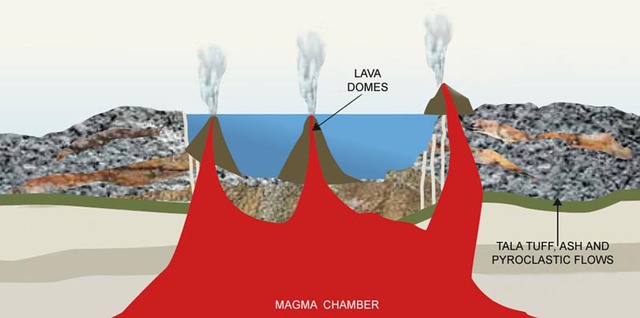
Since then, the magma chamber has become active in some way about once every 30,000 years. The most recent event was the eruption of El Colli, the big hill you can see just behind Guadalajara’s Omnilife Stadium, and El Tajo, the hill on which the Bugambillias housing development is located.
This book on the geology of the Primavera arrives just at the moment an ad-hoc group is pushing for the creation of a Geopark in the same forest, a place where local people and visitors from around the world can learn about the “passionate history” (as Barbara Dye calls it) of this caldera, while gazing at canyon walls, soaking in hot rivers and strolling among the bizarrely shaped rock formations produced here by nearly 100,000 years of volcanic activity. If Jalisco authorities take a liking to the idea, the Primavera Caldera could become the first UNESCO Geopark in Mexico, and join an international network of 90 Geoparks which now attract geotourists from all over the world.
As happens with so many government-sponsored publications in Mexico, this fine book may be available only for a limited time. If you want a copy, try calling the park’s office in Guadalajara at (52) 333 110-0917.

